54 6.2 OVERVIEW OF MAJOR RELIGIONS
6.2.1 Types of Religions
We often break religions into one of two basic types: ethnic and universalizing. Ethnic religions are associated within one group of people. They make little to no effort at proselytizing (converting others), although that possibility may exist. The largest ethnic religion is Hinduism. Judaism is another well-known ethnic religion. Through migration, both of these religions have become dispersed around much of the world, but they are closely tied to their own ethnic groups.
Universalizing religions seek to convert others. For some religions, it is a requirement for practitioners to spend part of their lives in missionary work attempting to convert others.
Another way of dividing religions is into the categories of polytheistic (many gods) and monotheistic (one god). Although the difference between monotheistic religions and polytheistic religions seems unbridgeable, there are religions that have managed to combine elements of polytheism and monotheism into the same religion. For example, in Voudon (Voodoo), entities that had previously represented African gods are recast as Catholic saints, who themselves are semi- divine in the Catholic cosmology. Combining two religions to create a new religion is known as syncretism.
6.2.2 A Brief Description of the Major Religions
Christianity
Christianity is a monotheistic religion centered on the life and teachings of Jesus of Nazareth. It dates to some time in the first century C.E. Christianity began within Judaism, and includes the Hebrew Bible (known to Christians as the Old Testament) as well as the New Testament as its canonized scriptures. Christianity has three main branches: Catholic, Eastern Orthodox, and Protestant (Figure 6.4). Catholic and Eastern Orthodox Christianity split in 1054, when the Catholic Pope and Orthodox Patriarch excommunicated each other over matters of preeminence. The Protestant/Catholic Schism began in 1517 with the distribution of Martin Luther’s 95 theses which challenged many of the practices of the Catholic Church.
The three branches of Christianity have their own spatiality, with a great deal of overlap between them. Orthodox Christianity began in the eastern half of the Roman Empire, centered in Constantinople, the capital of Byzantium. When it fell to the Muslim Turks in 1453, Russia became the center of Eastern Orthodox Christianity. Eastern Orthodox Christianity can also be found in Eastern Europe and Southern Europe with notable examples in Africa (Ethiopia) and in places where large numbers of people from these places have migrated (the United States, Canada). Catholic Christianity is seen in a wider range of places. It largely formed around the historic Roman Empire, then spread to northern and western Europe. Catholicism did not stop there, however. The age of colonial expansion which began in the fifteenth century transplanted Catholicism to such widespread places as the Philippines, much of the Americas and Caribbean, and large parts of Africa. Protestantism is the most recently developed Christian branch, but it has also diffused widely. The initial Protestant countries were in northern Europe, but again due to colonialism, Protestant Christianity was exported to places like the United States, South Africa, Ghana, and New Zealand. The current expansion of Christianity, particularly in Asia, is largely composed of Protestant Christians.
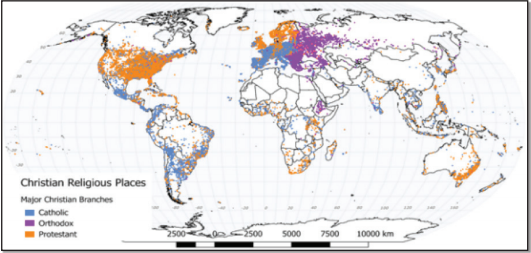
Figure 6.4 | Christian Places 4
This dot map shows structures designated as Christian from OpenStreetMap. Note how it varies from Figure 6.2 in that it shows a religious landscape that is more fragmented and interspersed.
Author | David Dorrell
Source | Original Work
License | CC BY SA 4.0
Each Christian branch has developed a distinct appearance in the landscape. Eastern Orthodox churches are meant to invoke a sense of the divine. Buildings are elaborate, both inside and out, with statutes, paintings, carved woodwork and stained glass windows. Catholic churches also tend to be elaborate, in a similar vein to Orthodox churches, but with a different architectural tradition. Both began with Roman domes and arches, but Catholic churches took on a distinctive shape with the flying buttresses of the Gothic tradition in the twelfth century. Protestant churches are much plainer, with straight, simple architectural lines and simple furnishings in the interior. This is a reflection of the early Protestant rejection of the rich and ornate display of the Catholic Church.
Islam
Islam is a monotheistic religion originating with the teachings of Muhammad (570-632), an Arab religious and political figure. The word Islam means “submission”, or the total surrender of oneself to God. An adherent of Islam is known as a Muslim, meaning “one who submits (to God).” Both Islam and Christianity inherited the idea of the chain of prophecy from Judaism. This means that figures such as Moses (Judaism) and Jesus (Christianity) are considered prophets in Islam. Muslims believe that Muhammad is the very last in that chain of prophecy. Islam has two main branches, and many smaller ones. The two main branches are Sunni and Shi’a. Sunni is much larger, comprising roughly 80% of all Muslims, though there are other forms of Islam. (Figure 6.5). The split between the two largest branches of Islam centered around the question of succession, that is to say, who would be the rightful leader of the Muslim world. Currently, there is no single voice for the global Muslim community. India has the third largest Muslim population, but there are five times as many Hindus in India as there are Muslims.
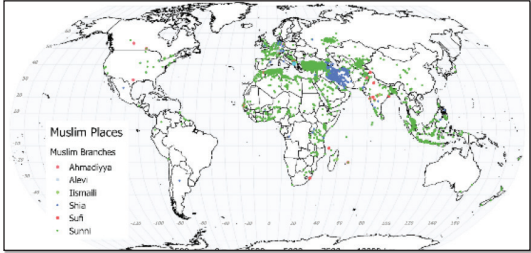
Figure 6.5 | Muslim Places 5
This dot map shows structures designated as Muslim from OpenStreetMap. The distribution of the different branches (particularly Sunni and Shia) belie any hard lines in the religious landscape.
Author | David Dorrell
Source | Original Work
License | CC BY SA 4.0
The Muslim world is somewhat more contiguous than the Christian world. This is mostly due to the fact that the Muslim expansion did not occur in two phases in the same way that Christianity did, the first which took place in Europe and the second with colonial expansion. As can be seen in the following map, Sunni and Shi’a countries are somewhat spatially separated. Only the countries of Iran, Iraq, Azerbaijan, and Bahrain are majority Shi’a. There are sizable minority Muslim sects in the world. Many of these groups, such as the Ahmadiyya, are subject to discrimination by other Muslim populations and/or governments. The world’s most theocratic governments are Muslim, particularly those of Iran and Saudi Arabia. This is notable in that these two countries are also regional rivals and the two most powerful states in the Muslim world.
Buddhism
Siddhartha Gautama, who was born into the Buddhism began within Hinduism and began withthat dates to the fifth century BCE. It was founded by Siddhartha Gautama near the modern border between Nepal and India. The three largest branches of Buddhism are Theravada, Mahayana and Vajrayana (Figure 6.6). The main differences between the branches are their approaches to canonized doctrine.
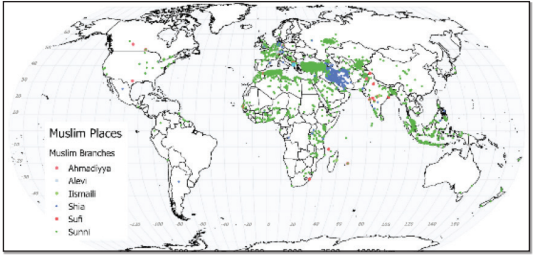
Figure 6.6 | Buddhist Places 6
This dot map shows structures designated as Buddhist from OpenStreetMap. It does not break Buddhism into its major branches of Theravada, Mahayana, and Vajrayana.
Author | David Dorrell
Source | Original Work
License | CC BY SA 4.0
Hinduism
Hinduism is a religious tradition that originated in the Indian subcontinent (Figure 6.7). Its origins can be traced to the ancient Vedic civilization (1500 BCE), a product of the invasion of Indo-European peoples. A conglomerate of diverse beliefs and traditions that assembled organically over a period of centuries, Hinduism has no single founder. Due to its concurrent growth with Indian civilization, Hinduism has historically been tightly bound to the caste system, although the modern Indian state has worked to ameliorate the more damaging effects of this relationship.

Figure 6.7 | Hindu Places 7
This dot map shows structures designated as Hindu from OpenStreetMap. Although heavily associated with the modern Indian state, large numbers of Hindus now live elsewhere.
Author | David Dorrell
Source | Original Work
License | CC BY SA 4.0
Chinese Religions
Not strictly located in China, Chinese religions are closely tied to Daoism (a nature religion), Confucianism (a philosophy of living), and ancestor worship. Chinese religious structures are associated with people of Chinese descent within and external to China. Because of the diversity of religious practices and beliefs, this category is best thought of as a complex of beliefs, rather than a defined set of beliefs and practices.
Sikhism
Sikhism is a 15th Century amalgamation of Islam and Hinduism. It is in many ways emblematic of syncretic religions. Syncretic religions are created by the combination of two or more religions, with the addition of doctrinal elements to create cohesion between the disparate pieces. Founded by Nanak Dev Ji (1469 – 1539) Sikhism reconciles Hinduism and Islam by recasting Hindu gods as aspects of a single god, in a manner similar to the Catholic Trinity. Although heavily associated with the Punjab region of the Indian subcontinent, Sikhism has spread widely through relocation diffusion (Figure 6.8). It has about 26 million adherents.
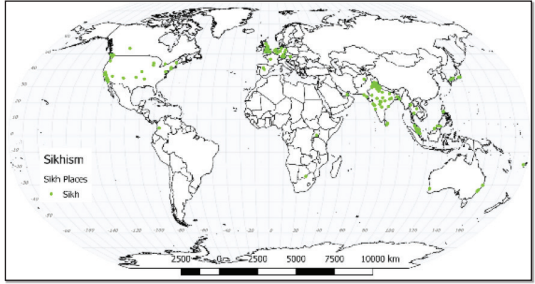
Figure 6.8 | Sikh Places 8
This dot map shows structures designated as Sikh from OpenStreetMap. Although originating in the Punjab on the Indian Subcontinent, it has diffused widely.
Author | David Dorrell
Source | Original Work
License | CC BY SA 4.0
Judaism
Judaism is a monotheistic religion originating in the Bronze Age in the eastern Mediterranean (Figure 6.9). Although it has no single founder, it holds the Torah as its holy book. In the modern context of Judaism, there are three major forms— Orthodox, Conservative and Reform—each with their own set of interpretations of correct practice. Judaism, as the initial Abrahamic religion, influenced other religions (particularly Christianity and Islam).
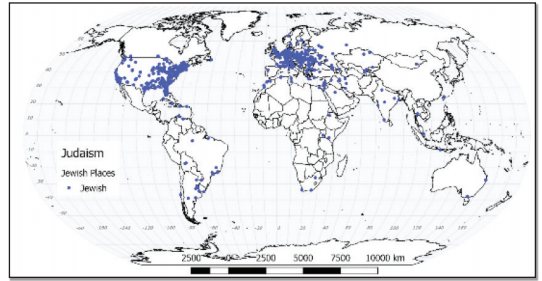
Figure 6.9 | Jewish Places 9
This dot map shows structures designated as Jewish from OpenStreetMap. It does not break Judaism into Orthodox, Conservative and Reform.
Author | David Dorrell
Source | Original Work
License | CC BY SA 4.0
Animism, Jainism, Bahai, Shinto, and Others
This catch-all category combines together religions that are all quite different. They are here due to their similar ties to places or ethnicities, not because they share any doctrinal or historical connections. Before continuing on a discussion of the following religions, it is important to make a point clear. It is possible to practice more than one religion. Many people in the world practice two or more religions with no sense of contradiction. In many parts of the world, pre-Christian or pre-Islamic beliefs persist alongside the newer religions.
Animism is a broad category, found in a variety of environments (Figure 6.10). The underlying theme is the idea that almost anything in the environment- people, mountains, rivers, rain, etc. is alive and worthy of recognition as such. Animism is frequently practiced with other ideologies or philosophies.
Baha’i was founded by Mirza Husayn Ali Nuri (1817-1892) in 1863. Baha’i was an offshoot of another religion, Babism, that in itself was a derivative of Islam. Although traditional Muslims believe that Muhammad was the last of the prophets (the seal of the prophets) many religions have been founded on the idea that there could be other, later people who also spoke for god. Baha’is believe that new messengers would be sent to humanity to remind people of their universal relationship to god and one another. The late date and historic context of this religion informed a religion that explicitly rejected racism and nationalism. One of the notable characteristics is that although Baha’is are not one of the larger religions on Earth, they have a temple on every permanently inhabited continent.
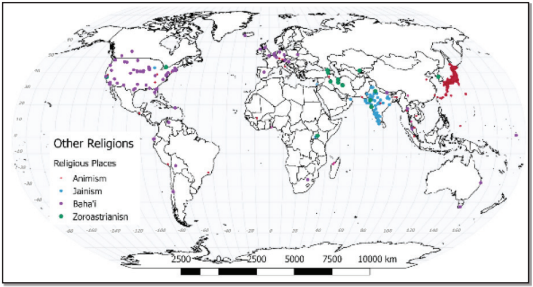
Figure 6.10 | Other Religious Places 10
This dot map shows some structures designated as Animist, Jain, Baha’I, and Zoroastrian from OpenStreetMap.
Author | David Dorrell
Source | Original Work
License | CC BY SA 4.0
Jainism is another ancient religion that arose in India. It is best known for its concept of ahimsa, or nonviolence.
Shinto, the ethnic religion of Japan is often practiced in conjunction with Buddhism. It is polytheistic and dates back centuries. The most important consideration of Shinto is that the rituals are so ingrained in Japanese national identity that the religion can either be considered vibrant and relevant, or moribund and ritualistic, depending on the perspective of the viewer.
Syncretic Religions
Syncretic religions are formed by the combination of two or more existing religions to produce a new religion (Figure 6.11). Some of the larger syncretic religions have already been mentioned, such as Baha’i or Sikhism.
Cao Dai is a religion founded in twentieth century Vietnam. It has strains of Taoism and Buddhism and represents an attempt to reconcile many diverse religious traditions into a single religion.
Voodoo arose in French Caribbean colonies as a combination of Catholicism and the beliefs of another set of West African peoples, the Ewe and the Fon. Practitioners speak to God using intercessors called loa that function as saints do in both the Catholic and Sufi worlds.
Candomble is a syncretism formed from many West African religious traditions and Catholicism. It has existed in Brazil for centuries. It believes in a creator god (Oludumare) and a series of demi-gods (Orishas).
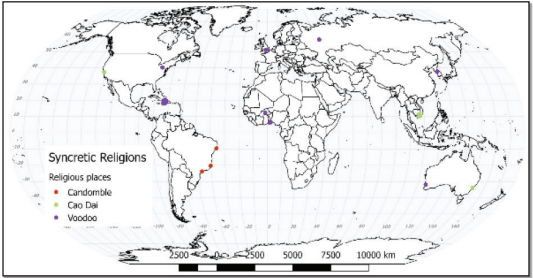
Figure 6.11 | Syncretic Religions 11
This dot map shows structures designated as Candomble, Voodoo, or Cao Dai from OpenStreetMap. Notice that Cao Dai has diffused from its origin in Vietnam to Australia and the United States.
Author | David Dorrell
Source | Original Work
License | CC BY SA 4.0
New Religions
Much like any other human phenomena, new religions are formed continuously. They are usually adaptations or combinations of existing religions. It is impossible to list the most recent arrivals. This category includes such religions as Scientology, the Unification Church, Seicho no Ie and Wicca.
What about the Nonreligious?
Sometimes the nonreligious are considered a religion unto themselves. This is generally not true. The nonreligious category is amorphous. There are no documents of beliefs that all nonreligious people must abide by. There is no over- arching nonreligious creed. It is another catch-all category that contains a large, diverse population with divergent beliefs and practices. Within these categories, however, there are notable manifestations. First, there are those places which are officially atheistic or non-religious. This label is problematic. It provides only the perspective of the government of these places. In many places that officially have no religions, practitioners simply do not advertise their religious affiliations. In other places, religious attendance has declined to a point that many people have no connection to a particular religious tradition. The label agnostic refers to the idea that the existence of a higher power is unknowable. It is important to point out that religions do not necessarily require the existence of a god-like force. Daoism relies on nature as its driving force.
